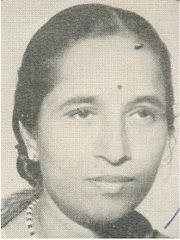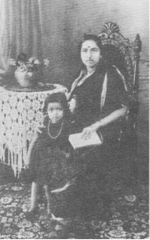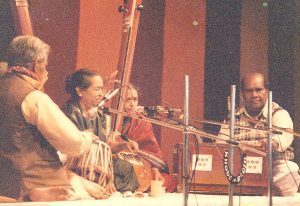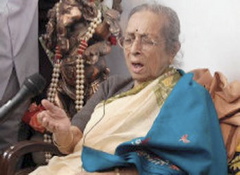Indian music music: Gangubai Hangal India Indian music khyal Kirana gharana musical history
by Warren
7 comments
Meta
SiteMeter
Brighter Planet
In Memoriam: Gangubai Hangal, 1913 – 2009
A tiny woman with a preternaturally deep voice, Gangubai Hangal achieved national fame in India as one of the greatest singers of the ornate improvisational artsong called khyal (“imagination” in Arabic). She died on Tuesday, July 21st, 2009, at a hospital near her home in Hubli, Karnataka State, India. She was ninety-seven years old and had given her last public concert two years before.
She overcame the dual barriers of caste and gender to become a nationally revered and respected artist. Her life was marked by rejection and sorrow, but her extraordinary voice and powerfully emotional singing brought her acclaim and international recognition.
Her story spans almost a century; her life as a professional performer lasted at least seventy-five years. Keep reading, and find out about Gandhari “Gangubai” Hangal, a woman who triumphed over tragedy to become one of the century’s greatest voices.
In the India of 1913, the caste system sustained an all-but-impenetrable set of barriers for social advancement. The little girl named Gandhari was born in the town of Dharwad in what is now Karnataka State. Her family was shudra (low caste); her female relatives were singers. In those days, a female singer was assumed to be, if not a prostitute, at least a woman of questionable character.
Growing up in these circumstances meant social rejection and stigma:
Of some childhood experiences in a predominant brahmin neighbourhood, Gangubai says: “I remember stealing fruit from our neighbour’s mango trees. More than the act of stealing, I remember the neighbours being horrified that a singer’s daughter should step into their compound.
Her mother Ambabai was an expert in South Indian music, a highly esteemed performer of the songs of Karnatak tradition. When her daughter’s talent in the North Indian Hindustani form became evident, she…
….actually stopped singing when young Gangu started her lessons. “I used to learn from Krishnamachari Hulguru, a student of Abdul Karim Khan Saab. I was very weak in taala (rhythm) and so during my lessons my mother would keep the beat on my back. Once when she told him that I had to get better with my rhythm, he got angry and demanded his fees for six months that instant.” They led a hand-to-mouth existence and Ambabai had no money on her. She gave him a gold ornament she had. But the angry teacher threw it and stormed out of the house.
A young Gangubai Hangal.
Gangubai’s talent was recognized early, and she began performing and recording. In 1924, at a meeting of the Indian National Congress, she sang for Gandhi. But even in the presence of the Mahatma, she felt the sting of caste discrimination:
Gangubai, along with five classmates, sang the invocation “Svagatavu Svagatavu Sakala Jana Sankulake”. Those were times charged with the spirit of nationalism and Gangubai was elated that she was singing before Gandhiji. But beyond all this, she was worried that, born in a low caste as she was, she might be summoned to clean the place once the upper castes had eaten. Her schoolteacher asked her to eat with everybody else and Gangubai, full of trepidation, could barely lift her head.
In 1929, she was sixteen. Time to get married.
Following the footsteps of her mother, Gangubai married Gururao Kaulgi, a Brahmin lawyer as women of her community had the option of settling down with a patron.
Kaulgi was much senior in age to Gangubai who was 16 when the alliance happened.
That same year, her daughter Krishna was born.
Her first recordings were made in 1933. She traveled to Bombay to sing for the Indian franchise of H.M.V. The records were popular and brought her acclaim.
Gangubai in 1935, singing the cheerful pentatonic raga Durga.
In 1937 she began arduous study with “Sawai Gandharva,” the foremost disciple of the great singer Abdul Karim Khan. Her teacher lived in another town, not far away by train:
Gangubai used to travel from Hubli to Kundgol by train every evening, accompanied by her uncle Ramanna.
Crowds in the vicinity jeered her and the faces craning out of windows greeted her with contempt whenever she visited Kundgolkar’s place. But she remained stoical and never allowed her passion for music to be subdued by the social ridicule.
When he fell ill, she moved to Bombay to take lessons with him. He used to put her through rigorous practice and could not be satisfied easily. “I remember a time when I was taught a particular phrase. Ga ga ri sa ni sa, nini ni da pa ma pa, ga ga ri sa ni da pa ma ga ri sa. I locked myself up in the room from morning to evening and practised it for more than 200 times. I was in tears, because my guru would not tell me if it was okay. Finally, late in the evening, he came over and told me I could stop.”
She moved to Bombay to continue working under his direction. At some point she had tonsillitis, and discovered after the operation that the register of her voice had changed. This tiny woman, less than five feet tall and weighing under a hundred pounds, now had a deep, booming voice.
…she saw it as a blessing. “Now it is closer to my guru’s voice”, exults this longtime resident of Hubli.
Established as a professional musician, Gangubai went through years of privation. She sharply debunked the notion that her music provided a means of escape from her poverty:
“Peace of mind is very essential in anything that you do — particularly in music. But in my case, it was just the opposite. What new things could I learn when I was constantly disturbed and unhappy? And I tell you, this whole concept of getting lost in music and forgetting the world around you, is a myth. In my case, I can openly say that my troubles and problems were not forgotten by just holding the tanpura in my hand. When I would sit down for riyaz (practice), I would, on the contrary, break down and cry over the daily scene. Over the question of just surviving through the next day. And it wasn’t for me that I was worried, but for the entire family that I supported. I personally never thought of becoming rich, of having a new car or house. Those ambitions never entered my mind. All I knew then was the money was not enough. There were many humiliations I had to face because of this. A certain lady musician in Pune invited me over to her house one day. Her mother asked how much I charged for a concert. I told her Rs 125. She suggested that I move over to Pune and accept all her daughter’s rejected programmes. They knew I was very badly off. I was insulted by this suggestion and left their house immediately. But later I thought that maybe they were trying to be helpful.”
Poverty is the norm for most Hindustani musicians, except for the few celebrities at the absolute top of the heap, and those fortunates who came from wealthy families. While Gangubai achieved great fame, it was not until she had reached an advanced age that she was free from financial worries.
Her husband was a lawyer, but his practice failed. So, too, did his investments and business ventures:
Her selfless devotion to him was never considered a sacrifice by her and even though he was a brahmin, a lawyer, it was ironically she who supported him throughout. “He did not practise law and so whatever money I earned, I just placed before him. He invested in business–trucks, cars–but lost everything. I could not bear to see him unhappy. Often he would disappear from home for months on end. The bank people would come and harass me, ask for my property as I was unable to repay the loans. This happened several times. I had to sell everything I had. I will never forget or forgive myself for not being by his bedside before he died. I had a programme in Bombay, but I did not want to go. He insisted because we needed the money. While I was performing, he died.”
As Gangubai got older, her voice deepened even further. A vocal style that normally depends on delicacy of tone and subtle inflection was transformed; her brush became very broad, her enormous voice carrying a huge emotional load with a minimum of decoration. Her daughter Krishna sang on stage with her, and the voices of the two women blended in a cross-generational communion that created a sense of deep timelessness. Krishna Hangal never married, remaining her mother’s constant companion until her death of cancer in 2004.
“There are some moments of happiness that I want to cling to. I want to make them permanent. But how is that possible?” She extends the same logic to her music. There were times when people gave her a thunderous applause. But it did not necessarily satisfy her.
“There was some phrase, some note that I wanted to hold on to that came in a flash. Pity these things are transient.” That strand of philosophical thought suddenly reminds her of her late daughter, and she starts crying inconsolably. “No parent should live to see their children die. Krishna was so talented. She had a naturally mellifluous voice that did not need much practice.” Krishna chose not to get married and lived her life as her mother’s shadow.
L to R: Sheshgiri Hangal, Gangubai Hangal, Krishna Hangal, Appa Jalgaonkar. Pune, Maharashtra, 1985.
I first heard Gangubai sing in 1985 (that’s when I took the photograph above). It was the last slot of a full festival night of music, and she and her daughter (with Gangubai’s brother Sheshgiri playing tabla accompaniment) performed a long rendition of the morning raga Asavari as the sun was starting to rise in the sky. I had never heard anything quite like it before. Most khyal singers offered delicacy and subtlety; Gangubai was forceful, eschewing nuance. The overwhelming impression was one of raw and unmediated feeling. Knowing nothing about her, I felt that she inhabited the severe, austere and melancholy atmosphere of Raga Asavari with more emotional veracity than I had ever thought possible.
Actually, I didn’t like it all that much; it made me uncomfortable. But over the years I heard Gangubai sing again and again, and I came to appreciate her as a great artist. There was no entertainment value in her music, only utter and complete honesty. Krishna’s voice was lighter, providing brief flashes of delicacy that served to highlight the stark and unyielding quality of the mother’s.
In 1986, traveling through Karnataka as part of the entourage of the great singer Bhimsen Joshi, I had lunch at her house. She served me graciously, but did not try to converse. Schooled only to the 5th grade, she knew no English. I knew no Kannada. It didn’t matter. The food was delicious.
Gangubai Hangal lived through nearly a century of change in her own country and the world. When she was born, the thought that she would be anything other than a professional singer/courtesan was inconceivable. Culturally bound by caste and gender restrictions, she refused to allow them to hinder her. She lived to see her performance venues change from the courts of princely states to the inside of All India Radio studios and concert halls in the West; in the course of a seventy-five year performing career she recorded 78rpm discs, LPs, cassettes and CDs. None of it affected her. She was nostalgic for the days when she could sing for an audience that included other master musicians:
…Gangubai recalls the grand old days of the All India Music Conference, when the best in the music world–Omkarnath, Kesarbai, Bismillah Khan, Allauddin Khan, Siddeshwari Devi and many others would come for nine days, from December 25 to January 1 every year and hear each other sing. Each artiste was assigned two sittings. “It was a great experience. Unfortunately those days are over. Nowadays, you seldom see an artiste listening to another artiste. Also, the sangeet jalsas, would go on for hours. I remember the tickets were priced at 50 paise for sitting on the ground and a rupee for a chair! All this may sound quaint today.
“But there was a strong bond between us artistes in the old days. I remember when Siddheshwari Devi was laid in bed with paralysis, we went to meet her and asked her if she needed help. She asked me to sing Bhairavi for her. She listened with tears in her eyes.” Link
Here is Gangubai in 1961, singing the powerful morning raga Komal Re Asavari:
In 1971, she was awarded the Padma Bhushan, one of the most prestigious civilian awards in India. Her response?
…she ran to her maternal uncle Ramanna’s house in the dead of night when she received a telegram that said she had been conferred the Padma Bhushan, and cried till the next morning, remembering all her hardships. By this time, her mother, teacher and husband were dead. “The difficulties of my life were like orchestra to my music,” she says.
Link
In 2007, Gangubai Hangal gave her last public performance. She sang for twenty minutes, presenting the complex raga Jaijaivanti to a small audience near her home.
By the end of her life, she had become a symbol of India’s progress, an inspiration for young people, and an example of a triumph over adversity. The sorrows and privations she endured marked her as a person and as an artist, but she persevered.
Gangubai hosting a crowd of youngsters at her home.
Ninety-seven years old, her eyes still saw clearly. She donated them:
The vocalist set an example for others to follow by donating her eyes. Gangubai had pledged to donate her eyes to the Eye Bank run Dr M.M. Joshi Eye Institute and her family members allowed Dr M.M. Joshi and his staff to carry out the necessary surgery.
Dr Joshi told the reporters that her eyes were in good condition. There were around 200 visually impaired persons waiting for corneal transplant and two of them would be benefited by the eye donation.
Thank you, Gangubai.
Requiescat in pace.
Thank you, Warren. This made me weep. Beautiful tribute of a great, great spirit and singer. What a tragic life! And yet, such strength amid all those losses! I am inspired.
Thank you for this wonderful blog post.
I would appreciate more visual materials, to make your blog more attractive, but your writing style really compensates it. But there is always place for improvement
A very informative, touchy and inspiring read. Thanks so much!
usefull info, keep up the good work. I’ll try to follow you more often






wonderful tribute